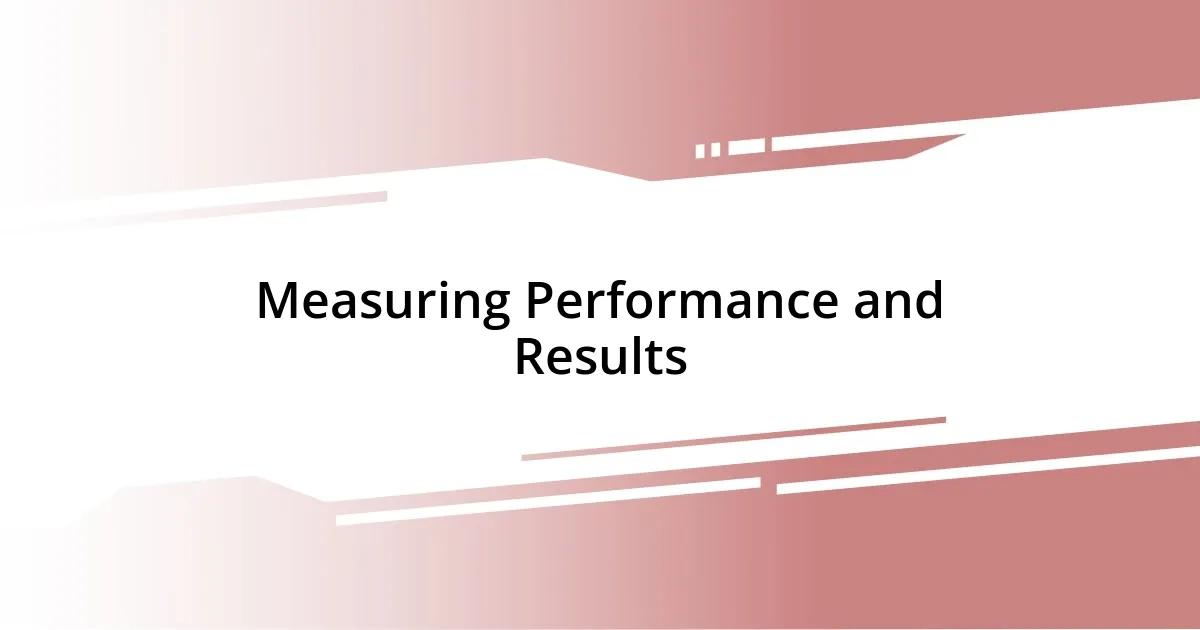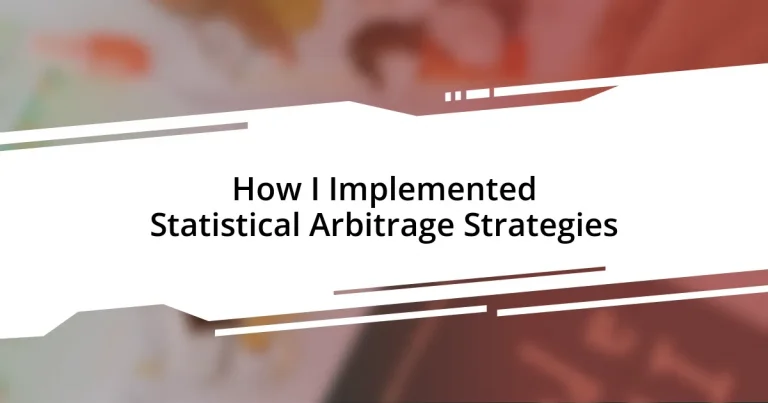Key takeaways:
- Statistical arbitrage involves using quantitative models to exploit mispriced securities, emphasizing the blend of data analysis and market intuition.
- Identifying the right market conditions and macroeconomic indicators is crucial for successful trading strategies, as they significantly impact trade outcomes.
- Backtesting is essential for validating strategies, highlighting the necessity of including diverse market scenarios and out-of-sample testing for reliable insights.
- Effective risk management through setting stop-loss levels, diversification, and proper position sizing can significantly enhance overall trading performance.

Understanding Statistical Arbitrage Strategies
Statistical arbitrage strategies revolve around identifying mispriced securities and exploiting these discrepancies through quantitative models. I remember the first time I came across this concept; it felt like finding a hidden treasure map in the clutter of traditional investing. How exciting is it to think about making money while the market seemingly moves against you?
In my experience, these strategies often involve complex algorithms that analyze historical data to predict future price movements. Each time I tweak the model parameters, it feels like conducting an experiment—there’s an exhilarating rush when the data suggests a profitable opportunity. But it also raises a question: how much of this is mere chance, and how much is skill?
With a foundation in statistical analysis, I find that the key is not just in selecting the right securities but also in understanding the nuances of timing and market conditions. It’s a blend of science and art, where intuition sometimes plays as big a role as the mathematics involved. I often ask myself, how can I optimize this approach further? Each day in this field presents a chance to learn and refine my strategies.

Identifying the Right Market Conditions
When I first started implementing statistical arbitrage strategies, I quickly realized that not all market conditions are created equal. Some days, the market moves smoothly, providing clear signals, while other times it feels chaotic, with volatility throwing my models off course. I always make it a point to assess market liquidity and overall sentiment since these factors can significantly impact results. How often have you noticed that a seemingly great opportunity can vanish in seconds due to erratic market conditions?
The economic environment plays a critical role, too. For instance, during times of economic uncertainty, correlations between assets may change, and what once appeared as a mispricing could suddenly become a market norm. I’ve personally experienced days when my algorithms suggested a robust trading opportunity, only to have the unexpected happen—like an earnings report or geopolitical event that completely disrupted the trend. Recognizing these shifts has allowed me to adapt my strategies in real-time.
Finally, I always keep an eye on macroeconomic indicators. These can help gauge whether it’s a good time to execute my strategies or take a step back. I remember a time when ignoring these indicators led to significant losses. It taught me a valuable lesson in respecting the wider economic landscape—sometimes patience is the smartest strategy in the toolkit.
| Market Condition | Example Impact |
|---|---|
| High Liquidity | Models function optimally |
| Market Volatility | Increased risk of model failure |
| Economic Uncertainty | Potential for mispricings |
| Strong Correlations | Improved predictability |

Developing a Trading Algorithm
Developing a robust trading algorithm is a challenging yet exciting journey. I remember spending countless hours coding and refining my algorithms, feeling a sense of pride when I finally saw them successfully execute trades. To create an effective algorithm, I focus on integrating several essential components:
- Data Acquisition: Ensuring I have access to high-quality, timely data that feeds the model accurately.
- Feature Selection: Identifying key variables that influence price movements, which can sometimes feel like piecing together a puzzle.
- Model Testing: Backtesting against historical data to see how the algorithm would have performed. This process can be both thrilling and nerve-wracking, as I hold my breath, waiting for results.
- Performance Metrics: Establishing clear metrics to evaluate success, like Sharpe ratio or maximum drawdown.
- Continuous Improvement: Iteratively refining the algorithm based on real-world performance, which makes the process feel more like an evolving project than a finished product.
In my earlier days, I often underappreciated the importance of balancing complexity and simplicity in my algorithms. It’s easy to get carried away with fancy models, yet I discovered that sometimes, the simplest solutions yielded the best results. I vividly recall one instance where I overcomplicated a strategy with too many variables, leading to confusion rather than clarity. After scaling back and focusing on a few solid indicators, I witnessed a significant uptick in performance—this reinforced my belief in the principle that less can often be more.

Backtesting Your Strategy Effectively
Backtesting is an essential part of implementing any statistical arbitrage strategy. In my experience, running a backtest with a rigid focus on historical data feels like an intense roller coaster ride—there are exhilarating highs when things go to plan and stomach-dropping lows when results don’t align with expectations. I often remind myself that backtesting is not merely a math exercise; it’s about capturing the essence of how my trading strategy would behave in real market conditions. Have you ever felt a similar thrill when crunching numbers, only to be unfazed later by the cold reality?
What I’ve learned is that incorporating a diverse range of market conditions in my backtesting can provide more reliable insights. Early on, I made the mistake of only testing during bull markets, which gave me a false sense of confidence. Once I expanded my tests to include periods of high volatility and downturns, I realized that my strategy often struggled in those scenarios. Adapting my approach helped me identify weaknesses early on, ultimately saving me from potentially costly mistakes in live trading. Isn’t it intriguing how much we can learn about ourselves and our strategies through the lens of backtesting?
I also emphasize the importance of validating out-of-sample data. At one point, I became so enamored with the in-sample results that I neglected to apply the same rigor to out-of-sample testing. When I finally did, I was faced with several surprising discrepancies. This experience was frustrating but enlightening, teaching me that models can perform well on historical data without guaranteeing future success. It’s a humbling reminder that the financial markets are unpredictable and that my approach, no matter how carefully crafted, always needs refinement and re-evaluation. How do you think your strategy would hold up under different market scenarios?

Managing Risk in Your Trades
When it comes to managing risk in my trades, I’ve learned the hard way that it’s all about setting clear stop-loss levels. Early in my trading journey, I faced a staggering loss simply because I hesitated to cut my losses. I thought, “Maybe the market will turn around,” but it didn’t. Now, I make it a rule to determine my exit points beforehand, which helps me stay disciplined during those adrenaline-fueled moments where emotions can cloud judgment.
Diversification is another crucial strategy I’ve embraced to mitigate risk. I remember when I was heavily invested in a single asset class, and suddenly, a market downturn left me reeling. That experience taught me that spreading risk across various assets can cushion the blow. Have you thought about how a mix of different instruments might protect your overall portfolio? By ensuring I have a balanced approach, I feel more secure when market volatility inevitably strikes.
Lastly, leveraging position sizing has been a game changer for me. I used to allocate too much capital to a single trade, which left me vulnerable. Now, I follow the rule of only risking a small percentage of my capital on any given trade. This strategy not only safeguards my overall portfolio but also allows me to absorb the occasional setback without losing my footing. Isn’t it reassuring to know that a methodical approach can lead to greater peace of mind?

Measuring Performance and Results
When measuring the performance of my statistical arbitrage strategies, I quickly realized that raw returns don’t tell the whole story. One time, I boasted a 15% return, but my drawdown was significant—over 20%. It felt like a hollow victory because I understood that high returns coupled with severe fluctuations could spell disaster in the long run. Have you ever celebrated a profit only to later realize it came with hidden risks?
I’ve found that metrics like the Sharpe ratio provide valuable insight; this ratio allows me to gauge the risk-adjusted return of my strategy. By comparing the returns of my trades with the risk taken, I felt empowered to make more informed decisions. There was a period when the Sharpe ratio was below 1 for my strategy, and addressing that became my mission. I knew something had to change. It turned out that refining my entry points and exit strategies significantly improved my performance. Isn’t it fascinating how a little tweaking can yield substantial progress?
Another metric I can’t overlook is win-loss ratio, which helps me understand not just the quantity, but the quality of my trades. Initially, I focused on the total number of successful trades, but this led to a false sense of security. Reflecting on it, I discovered that even a lower win-loss ratio could maintain profitability if the average winning trade outweighed the losses. That realization shifted my focus and transformed the way I approached my trading strategy. How do you measure success—by the number of wins or the impact they have on your bottom line?

Continuously Improving Your Approach
Continuously recalibrating my strategies has been a pivotal part of my trading journey. I often reflect on my approach, asking myself, “What worked? What didn’t?” During one particularly challenging period, I noticed that sticking to a rigid plan wasn’t yielding the expected results. It forced me to adapt and experiment with new indicators, refining my strategies in real-time. Has your trading ever felt stagnant? I think embracing flexibility can breathe new life into your approach.
Feedback loops have become my best friend. After each trading session, I take time to analyze what transpired, documenting lessons learned. For instance, I once made a trade based on a hunch rather than data and quickly regretted it. This prompted me to implement a post-trade review process, ensuring that every decision serves a purpose and adds to my growth. How often do you take a step back to review your own trading decisions? I find these moments of reflection are crucial for my improvement.
Attending trading workshops and seminars has also opened my eyes to new viewpoints. I remember participating in a session led by a seasoned trader who emphasized the importance of psychological resilience. Their insights changed my approach to setbacks; instead of viewing them as failures, I began to see them as invaluable learning opportunities. What if the next challenge you face could lead to unexpected insights and growth in your trading? I deeply believe that every experience—good or bad—can be a stepping stone toward continuous improvement.














